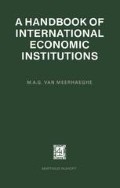Abstract
The following section deals with the commodity agreements. The one after that concerns UNCTAD, not only because this organization seeks to coordinate negotiations regarding these agreements, but also because it has attracted attention by its tendency to broach numerous subjects of a general nature.
The possibilities of commodity agreements are rather limited, since the technical and economic characteristics of many commodities and the nature of the trade in them preclude the useful application of international commodity agreements.
Harry G. Johnson
Access this chapter
Tax calculation will be finalised at checkout
Purchases are for personal use only
Preview
Unable to display preview. Download preview PDF.
Bibliography
A. Commodity Agreements
There are no recent extensive studies on the commodity agreements which may be described as thoroughgoing. Short surveys are given in Sir Sidney Caine, Prices for primary producers (2nd edn., London, Institute of Economic Affairs, 1966), who believes that price stabilization is too complex a matter to be tackled by any one device and that maximum play should be given to private action; R.G. Hawkins, J. Epstein and J. Gonzales, Stabilization of export receipts and economic development — International commodity agreements and compensatory financing (New York, New York University, 1966), who consider commodity agreements inappropriate for net transfers to the underdeveloped world; A.I. MacBean, Export instability and economic development (London, Allen & Unwin, 1966), Chapter 12, who discusses criteria for the effective operation of commodity agreements and finds that they have made little contribution to price stability; H.G. Johnson, Economic policies toward less-developed countries (Washington, D.C. Heath, 1967), Chapter 5: the agreements are relatively inefficient as a means of taxing the richer consuming countries in order to raise resources for the development of the poor countries; A.D. Law, International commodity agreements. Setting, performance and prospects (Lexington, Mass., D.C. Heath, 1975); W.H. Vermeulen, Grondstoffenovereenkomsten, in Organisaties en problemen op het gebied van de internationale handel (ed. P. VerLoren van Themaat, ‘s-Gravenhage, A.W. Sijthoff, 1977 ).
See also C.P. Brown, Primary commodity control (London, Oxford University, 1975); J.D.A. Cuddy, International price indexation (Westmead, D.C. Heath, 1976) and E. Brook et al.,Commodity price stabilization and the developing countries, Banca Nazionale del Lavoro,March 1978. For wheat see T. Grennes et al., The economics of world grain trade (New York, Praeger, 1978); for tin: W. Fox, Tin. The working of a commodity agreement (London, Mining Journal Books, 1974) by the former Secretary of the International Tin Council.
Most of the relevant data (but naturally no criticism on the operation of the agreements) are to be found in the publications of the various commodity councils.
Annual report for the crop year (annually since 1950); Review of the world wheat situation (annually since 1960); World wheat statistics (annually since 1955); International wheat prices (1962); Trends in wheat consumption (1964).
The Statistical Bulletin (monthly since 1937); Sugar yearbook (since 1958); Annual report and accounts (annually since 1954); World sugar economy structure and policies (2 vols, 1963).
Report of the International Coffee Organization for the period 1 July 1963–30 September 1966 and Resolution numbers 105–325 approved by the International Coffee Council (covers the period 22 August 1966–1 January 1971 ). Information on the working of the agreement can also be found in: Annual coffee statistics (Pan-American Coffee Bureau, New York) and Coffee annual (George Gordon Paton, New York).
The Statistical Bulletin (monthly since 1933); Statistical yearbook (every second year since 1937, and a supplement every other year); Annual report of the International Tin Council (annually since 1937).
The United Nations publishes reports on the commodity conferences, reflecting the views of producers and consumers and discussing the operation of any previous agreements.
B. UNCTAD
The most noteworthy of UNCTAD’s publications are the UNCTAD Commodity Survey,196—, and Handbook of international trade and development statistics (New York, UN, 1979); see also Proceedings of the United Nations Conference on Trade and Development (New York 1973 and 1978); Trade and Development. An UNCTAD Review (since Spring 1979).
B. Gosovic, UNCTAD. Conflict and Compromise. The Third World’s Quest for an Equitable World Economic Order through the United Nations (Leyden, A.W. Sijthoff, 1972); see also H.G. Johnson, The Kennedy round, op. cit.; idem, Economic policies towards less-developed countries, op. cit.; C.H. Kirkpatrick, UNCTAD V. Issues and prospects, Journal of World Trade Law, May—June 1979.
The extracts quoted are from. D.T. Healy, Development policy. New thinking about an interpretation, Journal of Economic Literature, Sept. 1972; H.G. Grubel, The case against the New International Economic Order, Weltwirtschaftliches Archiv, 1977, Heft. 2; M.E. Kreinin and J.H. Finger, A critical survey of the New International Economic Order, Journal of World Trade Law, Nov.—Dec. 1976.
Note: On 6 October 1979 the UN Conference on Natural Rubber adopted the text of an International Natural Rubber Agreement. It will come into force on 1 October 1980 if ratified. In order to stabilize prices the agreement relies on a buffer stock, the financial burden of which will be shared equally by exporters and importers.
Rights and permissions
Copyright information
© 1980 Martinus Nijhoff Publishers bv, The Hague
About this chapter
Cite this chapter
van Meerhaeghe, M.A.G. (1980). The Commodity Agreements. The United Nations Conference on Trade and Development (UNCTAD). In: A Handbook of International Economic Institutions. Springer, Dordrecht. https://doi.org/10.1007/978-94-009-8860-6_5
Download citation
DOI: https://doi.org/10.1007/978-94-009-8860-6_5
Publisher Name: Springer, Dordrecht
Print ISBN: 978-94-009-8862-0
Online ISBN: 978-94-009-8860-6
eBook Packages: Springer Book Archive

